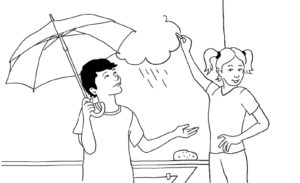Hint:
In contrast to the more sophisticated applications of language #26–28 (quasi-reality play, fictitious playing, theater plays) the following suggestions are very simple forms of role play that are, moreover, very much determined by the children themselves. In HLT, they are preferably practiced with the lowest age groups.
Procedure:
- The instructor divides the students in groups of 2–3 for the purpose of representing a scene that they have to imagine and play. The stronger and weaker students should be distributed such that the groups can cooperate well and all students contribute.

- Assignment to the groups: “Think of an everyday discussion scene that you would like to create, practice and present”. Additional suggestions may be required: Maybe something funny could be represented, a scene from your vacation in the country of origin, a language misunderstanding, something from school… Playing the scene may at most take 5 minutes.
- The groups have about 10 minutes to prepare, after which they play the scenes to each other or to the whole class. The other students provide feedback to a series of prepared questions, e. g., Why we liked this scene, why not? How was the representation and the comprehensibility? What caught our attention in terms of the language?
Variants:
- Instead of a scene from everyday life, a starting situation may be prescribed: something from the world of fairy tales, from the future (when you’re 50 years old), something from the world of animals, etc. See also #26–28.
Comments:
- Clear instructions are important: the time limit for preparation and play, no fight scenes or chasing anyone, but as much dialog as possible.
- The time required for this exercise can be varied as necessary. If more time is planned, the dialogs can be longer and the groups can be larger. Moreover, the dialogs can be enhanced with props and little backdrops.






